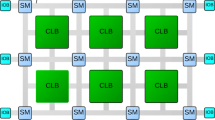Abstract
In this paper an effective Built-In Self-Test (BIST) scheme for the shifter-accumulator pair (accumulation performed either by an adder or an ALU) which appears very often in embedded processor, microprocessor or DSP datapaths is introduced. The BIST scheme provides very high fault coverage (>99%) with respect to the stuck-at fault model for any datapath width with a regular, very small and counter-generated deterministic test set, as it is verified by a comprehensive set of experiments.
Similar content being viewed by others
References
ARM9TDMI (Rev. 1), Technical Reference Manual, Nov. 1998.
R.P. Brent and H.T. Kung, “A Regular Layout for Parallel Adders,” IEEE Transactions on Computers, vol. C-31,no. 3, pp. 260-264, March 1982.
D. Gizopoulos, A. Paschalis, and Y. Zorian, “An Effective BIST Scheme for Datapaths,” ITC, pp. 76-85, 1996.
D. Gizopoulos, A. Paschalis, and Y. Zorian, “An Effective Built-In Self-Test Scheme for Booth Multipliers,” IEEE Design & Test of Computers, vol. 15,no. 3, pp. 105-111, July–September 1998.
D. Gizopoulos, A. Paschalis, and Y. Zorian, “An Effective Built-In Self-Test Scheme for Array Multipliers,” IEEE Trans. on Computers, vol. 48,no. 9, pp. 936-950, September 1999.
D. Gizopoulos, A. Paschalis, Y. Zorian, and M. Psarakis, “An Effective BIST Scheme for Arithmetic Logic Units,” Proc. of the IEEE International Test Conference, pp. 868-877, November 1997.
S. Gupta, J. Rajski, and J. Tyszer, “Arithmetic Additive Generators of Pseudo-Exhaustive Test Patterns,” IEEE Transactions on Computers, vol. 45,no. 8, pp. 939-949, August 1996.
B. Nadeau-Dostie, A. Silburt, and V.K. Agarwal, “Serial Interfacing for Embedded Memory Testing,” IEEE D&T of Comp., vol. 7,no. 2, pp. 52-63, April 1990.
C. Papachristou, S. Chiu, and H. Harmanani, “A Data Path Synthesis Method for Self-Testable Designs,” Proc. 28th ACM/IEEE DAC, pp. 378-384, 1991.
A. Paschalis, M. Psarakis, D. Gizopoulos, N. Kranitis, and Y. Zorian, “An Effective BIST Architecture for Fast Multiplier Cores,” Proc. of the IEEE Design Automation & Test in Europe, pp. 117-121, 1999.
J. Rajski and J. Tyszer, “Test Responses Compaction in Accumulators with Rotate Carry Adders,” IEEE Transactions on Computer-Aided Design of Integrated Circuits and Systems, vol. 12,no. 4, pp. 531-539, April 1993.
J. Rajski and J. Tyszer, “Arithmetic Built-In Self-Test for Embedded Systems,” Prentice Hall, 1997.
Synopsys, Design Ware Foundation Library Databook, vol.1, ver. 1999.05, February 1999.
Texas Instruments, TTL Data Book, vol. 2, Dallas, Texas, 1985.
M. Vahid and A. Orailoglu, “Testability Metrics for Synthesis of Self-Testable Designs and Effective Test Plans,” Proc. 13th IEEE VTS., pp. 170-175, 1995.
Y. Zorian and A. Ivanov “An Effective BIST Scheme for ROMs,” IEEE Trans. on Computers, vol. 41,no. 5, pp. 646-653, May 1992.
Y. Zorian, A.J. Van de Goor, and I. Schanstra, “An Effective BIST Scheme for Ring-Address Type FIFOs,” Proc. IEEE ITC, pp. 378-387, 1994.
Author information
Authors and Affiliations
Rights and permissions
About this article
Cite this article
Kranitis, N., Paschalis, A., Gizopoulos, D. et al. An Effective Deterministic BIST Scheme for Shifter/Accumulator Pairs in Datapaths. Journal of Electronic Testing 17, 97–107 (2001). https://doi.org/10.1023/A:1011113508662
Issue Date:
DOI: https://doi.org/10.1023/A:1011113508662




